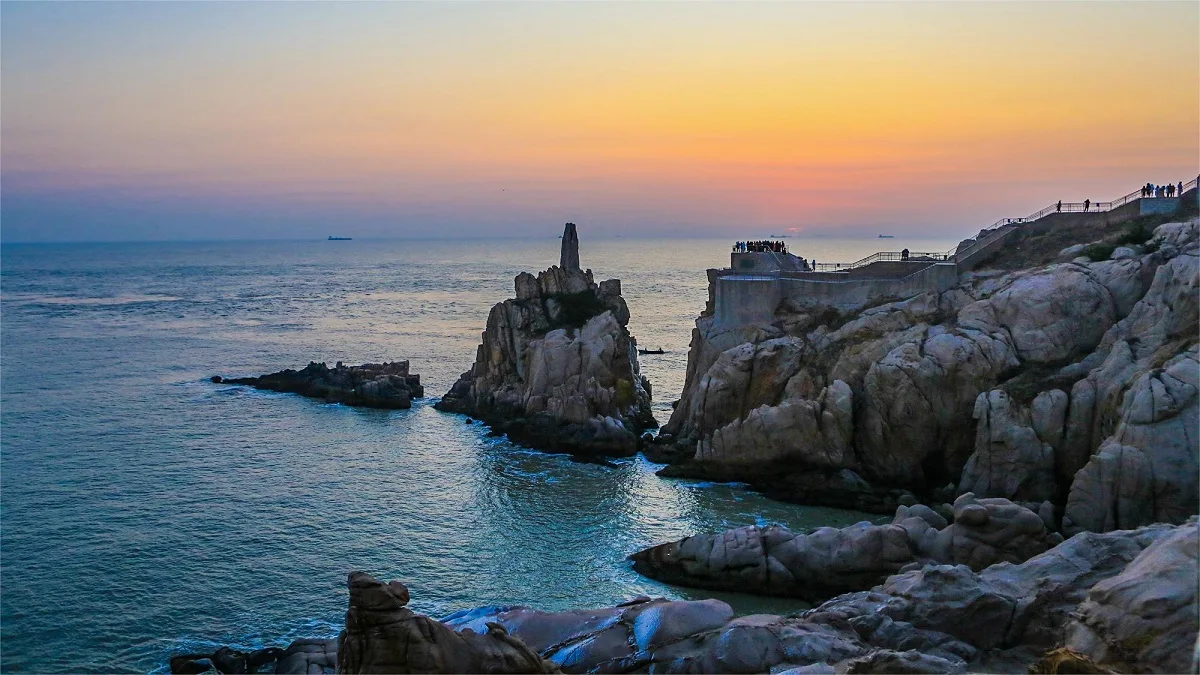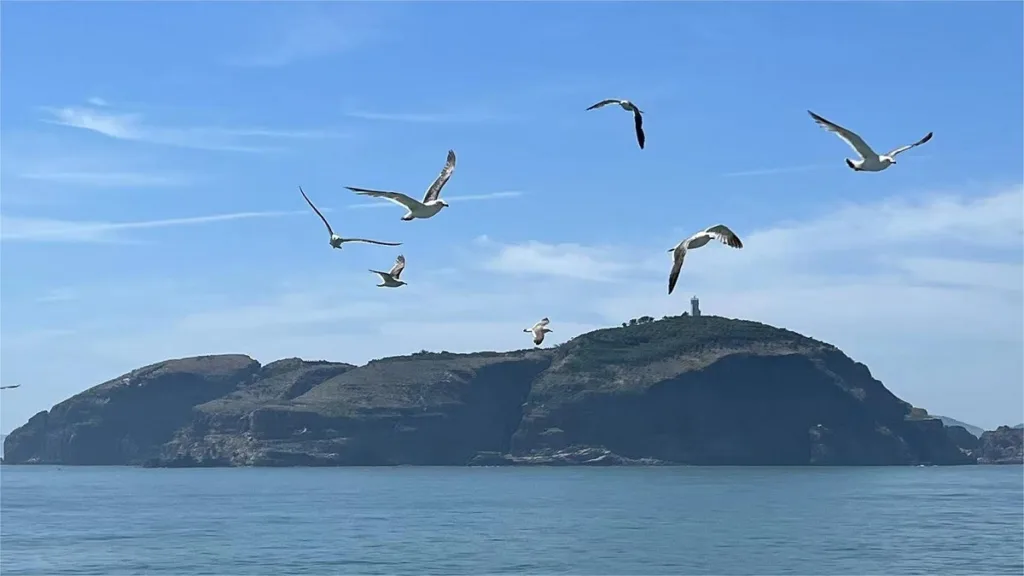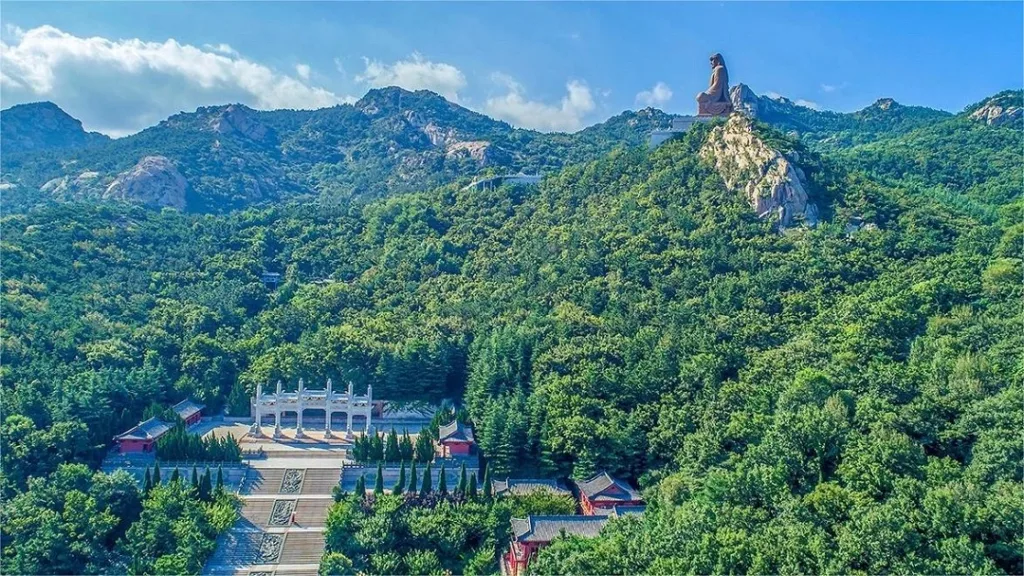Chengshantou (成山头, Head of Chengshan Mountain), also known as the “End of the Sky,” is located at the easternmost tip of the Chengshan Mountain Range. Surrounded by the sea on three sides and connected to the land on one, it lies just 5 nautical miles from the main international shipping route between the north and south, and 94 nautical miles from South Korea across the sea. Renowned as the earliest place to witness the sunrise over the sea, Chengshantou has been hailed as the “Place where the Sun Rises” since ancient times. During the Spring and Autumn Period, it was referred to as “朝舞 (Dance of the Sun in the Morning)” and is known as the “Cape of Good Hope of China.”
Chengshantou stands 200 meters above sea level, with a width of 1.5 kilometers from east to west and a length of 2 kilometers from north to south, covering an area of 2.5 square kilometers. The terrain is steep, offering views of multiple peaks and verdant trees. The cliffs meet the turbulent sea below, with swift currents and large waves, creating a dramatic and impressive scene. This location has long been considered an ideal summer retreat.
Chengshantou was named one of “China’s Most Beautiful Eight Coastlines” by China National Geographic. It ranks alongside Yalong Bay in Sanya, Hainan, and Yehliu in Keelung, Taiwan, as one of the top three most stunning coastal spots in China.
Table of Contents
- Basic Information
- Location and Transportation
- Map of Chengshantou
- Highlights of Chengshantou
- History of Chengshantou
- Vlog about Chengshantou Scenic Area
- Other Attractions in Rongcheng
Basic Information
| Estimated Length of Tour | 1 – 2 hours |
| Ticket Price | 148 RMB |
| Opening Hours | 7.30 – 18.00; Last admission: 16.30 |
| Telephone Number | 0086-0631-7834888 0086-0631-7834666 |
Location and Transportation
Chengshantou, also known as “the End of the Sky,” is located in Chengshan Town, Rongcheng City, Weihai, Shandong Province. To reach Chengshantou, visitors can take a direct bus from Weihai Bus Station to Xixiakou (西霞口). Buses run approximately every half hour, with a fare of about 15 yuan and a travel time of around 1.5 hours.
Map of Chengshantou

Highlights of Chengshantou
Shihuang Temple

Upon entering Chengshantou Park, visitors are greeted by a small temple on a nearby hill. This is the Shihuang Temple, named in honor of Emperor Qin Shi Huang, who is said to have visited this place twice, drawn by its reputation as the first place to witness the sunrise over the sea. This temple is unique as it is the only “Shihuang Temple” in China. The temple complex includes the Front Hall dedicated to the Sun God, the Main Hall of Qin Shi Huang, the East Hall for the Eastern Palace, the Deng Gong Temple, the Bell Tower, and a theater stage. The Deng Gong Temple commemorates Admiral Deng Shichang, a hero who sacrificed his life in the Sino-Japanese War of 1894-1895.
“End of the Sky” Inscription

After exploring the Shihuang Temple, a ten-minute walk through a shaded path leads to the “End of the Sky (天尽头)” inscription, which was later changed into “天无尽头 (Endless Sky)” for better overtone. The first sight that catches the eye here are several tall stone pillars, standing beside the Sea Viewing Corridor. From the corridor, one can take in the expansive, magnificent view of the vast ocean. The sea breeze, crashing waves, and the vast expanse of the ocean create a dynamic and captivating scene. Scattered across the sea are various rock formations, including the General’s Stone and the Little Stone Forest, offering a spectacular natural display. Additionally, nearby stands a bronze statue of Qin Shi Huang along with Li Si and Xu Fu.
The “End of the Sky” inscription itself is carved into a large stone, nearly ten meters high, located at the end of a rocky ridge extending into the sea. The gold-leaf lettering gleams brilliantly in the setting sun, creating a mesmerizing effect. Railings line the ridge and the platform around the stone, providing safety for visitors who wish to take photos or gaze out over the East China Sea.
History of Chengshantou
According to the historical records in the “Records of the Grand Historian” (《史记》), Chengshantou was once believed to be the dwelling place of the Sun God in ancient times. In 219 BC and 210 BC, Emperor Qin Shi Huang visited Chengshantou twice to worship the Sun God and seek the elixir of immortality, leaving behind historical relics and cultural landscapes such as the “Qin Bridge Remains,” “Qin Dynasty Steles,” and the “Shooting Seagull Platform.”
Emperor Qin Shi Huang referred to Chengshantou as “the End of the Sky,” and his Prime Minister Li Si inscribed the words “天尽头” (End of the Sky) on a stele at the eastern gate of the Qin Dynasty. In 94 BC, during the Eastern Expedition, Emperor Wu of Han, Liu Che, along with civil and military officials, visited Chengshantou and was awed by the spectacular sunrise over the sea. He subsequently ordered the construction of the Altar for Sun Worship, expanded the Sun Shrine, and composed the “Ode to the Red Geese” to express his gratitude and commemorate the event.
Throughout history, successive emperors continued the tradition of worshipping the sun at Chengshantou, making it a significant cultural and religious site in ancient China. The site’s association with celestial phenomena and imperial reverence contributed to its enduring historical importance and cultural significance.






1. If you’re bringing children, I recommend taking the little train in the park, or you can rent a car for 80 yuan to drive in yourself. Today it was quite windy, and after we drove in, we all felt that the 80 yuan was really worth it. 2. The End of the Sky really feels special; I suggest going in the afternoon. This way, the angle of the sunlight will make the sea look bluer. 3. There is a… Read more »
On April 19, 2025, the Weihai Fishermen’s Festivalwill be held at Chengshantou! The Fishermen’s Festival, also known as the Fishermen’s Opening Ocean Festival (渔民开洋) or the Thanks Ocean Festival (谢洋节), is a grand and solemn ceremony performed by the fishermen of Rongcheng to pray for safety and wish for a bountiful harvest.
Chengshantou is a scenic area, but I didn’t go in; I just strolled along the nearby beach. There are large areas of sea water farming here, and many fishing boats can be seen moving around these aquaculture sites.
I visited Chengshantou on New Year’s Day. The entrance ticket was 39.9 yuan, and the parking lot was quite spacious with very few people around. There are only three attractions in the scenic area: East Gate of Heaven, The End of the Sky, and Fortune Like the East China Sea. The End of the Sky was decent; I took a walk along the seaside and it was pretty exhausting. The southern side of the mountain was warm and sunny without… Read more »
We set off for Chengshantou around five o’clock. When we arrived, the sky was foggy, making it hard to distinguish directions. After asking a local elder for directions, we finally found the spot to watch the sunrise.
The park has a small train that transports visitors to various attractions for just 20 yuan, which is more convenient than driving yourself. When the weather is nice, the scenery is quite beautiful.
Aside from the “End of the Sky” (天尽头) monument, there weren’t any other noteworthy places to see in the scenic area. There were only a few scattered seagulls near the monument.
Chengshantou has a decent view, but it’s just too crowded and hot.